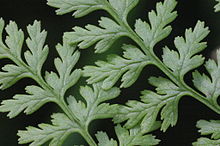Cystopteris montana, previously classified as Athyrium montanum, is a species of fern known by the common name mountain bladderfern.[1] It occurs throughout the high latitudes of the Northern Hemisphere, in Eurasia, Greenland, and Alaska, and throughout Canada. It is also present in the higher elevations in Colorado farther south.[2]
| Cystopteris montana | |
|---|---|

| |
| Scientific classification | |
| Kingdom: | Plantae |
| Clade: | Tracheophytes |
| Division: | Polypodiophyta |
| Class: | Polypodiopsida |
| Order: | Polypodiales |
| Suborder: | Aspleniineae |
| Family: | Cystopteridaceae |
| Genus: | Cystopteris |
| Species: | C. montana
|
| Binomial name | |
| Cystopteris montana | |
This fern produces a creeping, cordlike, scaly stem. The leaves are up to 45 centimeters long. The blades are borne on a petiole with a dark base and a light-colored end. The petiole is longer than the blade. The blade is pentagonal in shape and divided into leaflets which are subdivided into many lobed and toothed segments. The sori are covered in hairy, whitish, cup-shaped indusia.[2][3]
This fern grows in moist mountain habitat, such as forests near streams.[4]
References edit
- ^ USDA, NRCS (n.d.). "Cystopteris montana". The PLANTS Database (plants.usda.gov). Greensboro, North Carolina: National Plant Data Team. Retrieved 17 January 2016.
- ^ a b Cystopteris montana. Flora of North America.
- ^ Cystopteris montana. The Nature Conservancy.
- ^ Williams, Tara Y. 1990. Cystopteris montana. In: Fire Effects Information System, [Online]. U.S. Department of Agriculture, Forest Service, Rocky Mountain Research Station, Fire Sciences Laboratory.
External links edit
